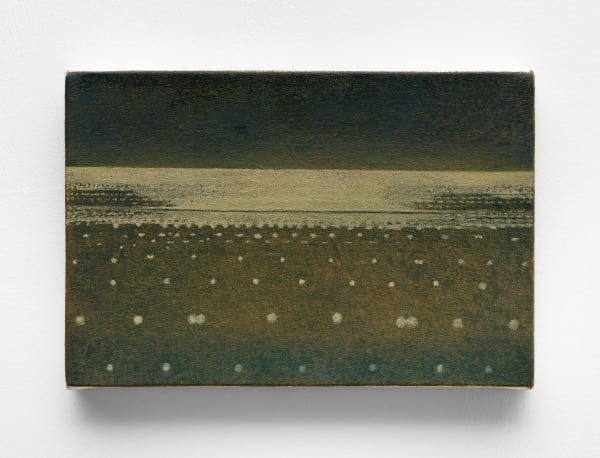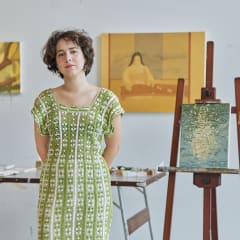Noites de cetim Paula Siebra
Past exhibition
Overview
Satin Nights: the darkness of memory and painting as relationship
I still keep in me
Satin nights
Ivory moons
Days of full sun
It is dusk on the beach. For a few minutes, the sky looks like ember before cooling down into a blueish black. The landscape eases down, keeping the memory of the day’s past, like an enchantment. Paula Siebra’s Satin Nights are memories of the heat coming from the sun that has already gone, but that remains under the skin; the memory of Amelinha’s song playing on the radio, whose verses have now become this essay’s epigraph. There is an island under the stars, artificial lights that shine faraway, the twilight, the absence of light. Recently-bathed children, a vase of flowers. The quietness of darkness.
Satin Nights is also the result of the artist’s research on and interest in “silica engraving”, the practice in which images – mostly landscapes – are created from the juxtaposition of colorful sand placed in translucent bottles. Siebra does not represent these objects; however, she establishes with them a profound dialogue, both in terms of her pictorial approach featuring fast chromatic, perhaps unexpected transitions, and in terms of a sense of belonging. It is not by chance that the exhibition also presents the work of artists who have kept this ancient technique alive: Dudui (Carlos Eduardo da Rocha) and Edgar Freitas.
The oil and egg tempera works are made with overlayers that produce a dense atmosphere, in which colors impact one another, in the same way that the sea water reflects the light in the sky, wet sand is darker and vegetation creates patches on dunes. “It is evident that colors vary because of light”, stated the Renaissance thinker Leon Battista Alberti, “since every color in shade does not appear as [the same color] placed under the rays of light.”[1] Colors oscillate by nature, as well as light and the tide.
Alberti, whose 15th century treaty is considered the first one to systematize a theory on painting, declares: “As a painter, I have […] this opinion about colors: that through their mixing one generates an almost infinite number of colors; but that among painters there are authentic kinds of colors conforming to the number of the four elements, from which numerous species are obtained. [...] There is the color of fire that they call red; then the color of air as well, which is called sky blue or azure; the color of water is green. The earth, instead, has the color of ashes.”[2] This is not trivial. By connecting the colors he sees as “authentic” to the four elements, Alberti is proposing a close relationship between painting and nature, as if they were made of the same matter: a relationship of interdependence.
Perhaps it is possible to say that Siebra’s works also arise from the encounter between artist and place, its colors, the matter from which it is made, the dyed sand placed in the bottles. They are not, therefore, disinterested compositions, but rather a sort of landscape — both natural and human — transfigured into painting, from darkness into a dense matter loaded with affection.
The images are what they appear to be: the sea, the sky, the sand, a vase of flowers, a jewelry box, a woman combing her hair. However, like in the song from which the exhibition borrows its title, the images evoke several other images that inhabit the spectator’s memory, always diverse and uncertain, and dependent on personal experiences.
There is a sense of generosity in Paula Siebra’s work, which is patiently built with small brushstrokes, with the accumulation of pigments: existence is always in relation to something else, in a sort of joint enterprise. For instance, the blue of the sky or sea in Falésias e areia molhada [Cliffs and wet sand] is alternated with an orangish tone underneath and around it. The iconographic elements also change meaning when placed side by side. Inside the jewelry box in Coisas da minha mãe [My mother’s things], there is an open lipstick, a glass bottle, and, amongst other objects, a pair of closed eyes. Underneath them, droplet-shaped earrings are turned into tears, echoing the curtain at the entrance of the exhibition room. Pearls are water that is precious — they are also an enigma, a personal story. Nothing exists except as a group. The woman in Mulher penteando o cabelo [Woman combing her hair], with the salt washed from her hair, seems to be recalling recent events, and the shape of her body brings into mind popular sculptures and wooden ex-votes, art objects that are deeply ingrained in the life and body of those who make them.
“Painting certainly has in itself a truly divine power […] because, as they say of friendship, a painting lets the absent be present”[3], wrote Alberti. In the same way that colors influence one another and the light also changes the quality of what we see, encounters between people can transform their experiences and work. The coexistence with other artists from the coast, memories of a sunny day, and shared technical knowledge are the fundamental materials that create the works, as well as the encounters between them and whoever else is interested in spending time in front of these friendship-paintings, evoking other images. Perhaps these are provisional, infinite Nights. As abundant as there are nights.
—Mariana Leme
[1] ALBERTI, Leon Battista. On Painting. New York: Cambridge University Press, 2011, p. 142. Translated by Rocco Sinisgalli.
[2] Idem, pp. 31-32.
[3] Idem, p. 44.
Satin Nights is also the result of the artist’s research on and interest in “silica engraving”, the practice in which images – mostly landscapes – are created from the juxtaposition of colorful sand placed in translucent bottles. Siebra does not represent these objects; however, she establishes with them a profound dialogue, both in terms of her pictorial approach featuring fast chromatic, perhaps unexpected transitions, and in terms of a sense of belonging. It is not by chance that the exhibition also presents the work of artists who have kept this ancient technique alive: Dudui (Carlos Eduardo da Rocha) and Edgar Freitas.
The oil and egg tempera works are made with overlayers that produce a dense atmosphere, in which colors impact one another, in the same way that the sea water reflects the light in the sky, wet sand is darker and vegetation creates patches on dunes. “It is evident that colors vary because of light”, stated the Renaissance thinker Leon Battista Alberti, “since every color in shade does not appear as [the same color] placed under the rays of light.”[1] Colors oscillate by nature, as well as light and the tide.
Alberti, whose 15th century treaty is considered the first one to systematize a theory on painting, declares: “As a painter, I have […] this opinion about colors: that through their mixing one generates an almost infinite number of colors; but that among painters there are authentic kinds of colors conforming to the number of the four elements, from which numerous species are obtained. [...] There is the color of fire that they call red; then the color of air as well, which is called sky blue or azure; the color of water is green. The earth, instead, has the color of ashes.”[2] This is not trivial. By connecting the colors he sees as “authentic” to the four elements, Alberti is proposing a close relationship between painting and nature, as if they were made of the same matter: a relationship of interdependence.
Perhaps it is possible to say that Siebra’s works also arise from the encounter between artist and place, its colors, the matter from which it is made, the dyed sand placed in the bottles. They are not, therefore, disinterested compositions, but rather a sort of landscape — both natural and human — transfigured into painting, from darkness into a dense matter loaded with affection.
The images are what they appear to be: the sea, the sky, the sand, a vase of flowers, a jewelry box, a woman combing her hair. However, like in the song from which the exhibition borrows its title, the images evoke several other images that inhabit the spectator’s memory, always diverse and uncertain, and dependent on personal experiences.
There is a sense of generosity in Paula Siebra’s work, which is patiently built with small brushstrokes, with the accumulation of pigments: existence is always in relation to something else, in a sort of joint enterprise. For instance, the blue of the sky or sea in Falésias e areia molhada [Cliffs and wet sand] is alternated with an orangish tone underneath and around it. The iconographic elements also change meaning when placed side by side. Inside the jewelry box in Coisas da minha mãe [My mother’s things], there is an open lipstick, a glass bottle, and, amongst other objects, a pair of closed eyes. Underneath them, droplet-shaped earrings are turned into tears, echoing the curtain at the entrance of the exhibition room. Pearls are water that is precious — they are also an enigma, a personal story. Nothing exists except as a group. The woman in Mulher penteando o cabelo [Woman combing her hair], with the salt washed from her hair, seems to be recalling recent events, and the shape of her body brings into mind popular sculptures and wooden ex-votes, art objects that are deeply ingrained in the life and body of those who make them.
“Painting certainly has in itself a truly divine power […] because, as they say of friendship, a painting lets the absent be present”[3], wrote Alberti. In the same way that colors influence one another and the light also changes the quality of what we see, encounters between people can transform their experiences and work. The coexistence with other artists from the coast, memories of a sunny day, and shared technical knowledge are the fundamental materials that create the works, as well as the encounters between them and whoever else is interested in spending time in front of these friendship-paintings, evoking other images. Perhaps these are provisional, infinite Nights. As abundant as there are nights.
—Mariana Leme
[1] ALBERTI, Leon Battista. On Painting. New York: Cambridge University Press, 2011, p. 142. Translated by Rocco Sinisgalli.
[2] Idem, pp. 31-32.
[3] Idem, p. 44.
Works
-
 Paula Siebra, Crepúsculo do Sul, 2022
Paula Siebra, Crepúsculo do Sul, 2022 -
 Paula Siebra, Ilha, 2022
Paula Siebra, Ilha, 2022 -
 Paula Siebra, Coisas da minha mãe, 2022
Paula Siebra, Coisas da minha mãe, 2022 -
 Paula Siebra, Mulher penteando o cabelo, 2022
Paula Siebra, Mulher penteando o cabelo, 2022 -
 Paula Siebra, Flores da noite, 2022
Paula Siebra, Flores da noite, 2022 -
 Paula Siebra, Luar, 2022
Paula Siebra, Luar, 2022 -
 Paula Siebra, Anoitecer nas dunas no. 3, 2022
Paula Siebra, Anoitecer nas dunas no. 3, 2022 -
 Paula Siebra, Breu, 2022
Paula Siebra, Breu, 2022 -
 Paula Siebra, Dunas à noite, 2022
Paula Siebra, Dunas à noite, 2022 -
 Paula Siebra, Duas jangadas de madrugada, 2022
Paula Siebra, Duas jangadas de madrugada, 2022 -
 Paula Siebra, Amanhecer na serra, 2022
Paula Siebra, Amanhecer na serra, 2022 -
 Paula Siebra, Areal, 2022
Paula Siebra, Areal, 2022 -
 Paula Siebra, Falésias e areia molhada, 2022
Paula Siebra, Falésias e areia molhada, 2022 -
 Paula Siebra, Casas nas dunas, 2022
Paula Siebra, Casas nas dunas, 2022 -
 Paula Siebra, Crepúsculo do Sul, 2022
Paula Siebra, Crepúsculo do Sul, 2022 -
 Paula Siebra, Lagoa, 2022
Paula Siebra, Lagoa, 2022 -
 Paula Siebra, Hora dourada, 2022
Paula Siebra, Hora dourada, 2022
Installation Views


















